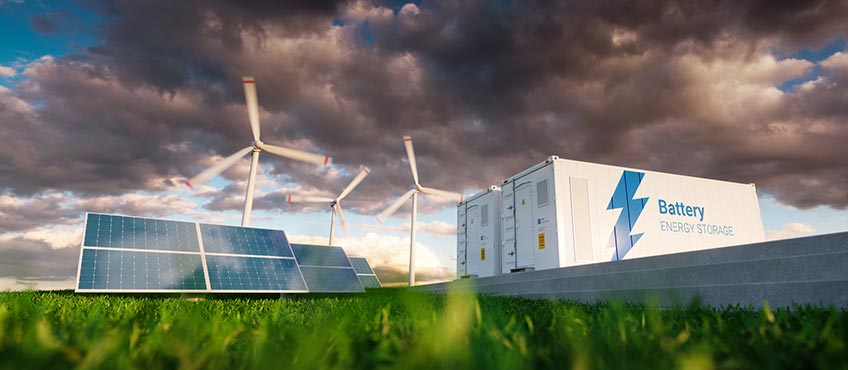Grid-Scale U.S. Storage Capacity Could Grow Five-Fold by 2050
Latest Report in Storage Futures Study Shows Reaching Full Market Potential Hinges on System Flexibility, Solar PV Penetration

With declining technology costs and increasing renewable deployment, energy storage is poised to be a valuable resource on future power grids—but what is the total market potential for storage technologies, and what are the key drivers of cost-optimal deployment?
In the latest report from the Storage Futures Study (SFS), Economic Potential of Diurnal Storage in the U.S. Power Sector, NREL analysts Will Frazier, Wesley Cole, Paul Denholm, Scott Machen, and Nate Blair, describe significant market potential for utility-scale diurnal storage (up to 12 hours) in the U.S. power system through 2050. They found storage adds the most value to the grid and deployment increases when the power system allows storage to simultaneously provide multiple grid services and when there is greater solar photovoltaic (PV) penetration.
“We find significant market potential for diurnal energy storage across a variety of modeled scenarios, mostly occurring by 2030,” said Will Frazier, National Renewable Energy Laboratory (NREL) analyst and lead author of the report. “To realize cost-optimal storage deployment, the power system will need to allow storage to provide capacity and energy time-shifting grid services.”
The SFS—led by NREL and supported by the U.S. Department of Energy's (DOE's) Energy Storage Grand Challenge—is a multiyear research project to explore how advancing energy storage technologies could impact the deployment of utility-scale storage and adoption of distributed storage, including impacts to future power system infrastructure investment and operations.
Expanded Capabilities to Model Storage Potential
For this work, researchers added new capabilities to NREL’s Regional Energy Deployment System (ReEDS) capacity expansion model to accurately represent the value of diurnal battery energy storage when it is allowed to provide grid services—an inherently complex modeling challenge. Cost and performance metrics focus on Li-ion batteries because the technology has more market maturity than other emerging technologies. Because the value of storage depends greatly on timing, ReEDS simulated system operations every hour.
NREL researchers used ReEDS to model two sets of scenarios—one that allows storage to provide multiple grid services and one that restricts the services that storage can provide. All the scenarios use different cost and performance assumptions for storage, wind, solar PV, and natural gas to determine the key drivers of energy storage deployment.
Installed Storage Capacity Could Increase Five-Fold by 2050
Across all scenarios in the study, utility-scale diurnal energy storage deployment grows significantly through 2050, totaling over 125 gigawatts of installed capacity in the modest cost and performance assumptions—a more than five-fold increase from today’s total. Depending on cost and other variables, deployment could total as much as 680 gigawatts by 2050.
“These are game-changing numbers,” Frazier said. “Today we have 23 gigawatts of storage capacity, all of which is pumped-hydro.”
Initially, the new storage deployment is mostly shorter duration (up to 4 hours) and then progresses to longer durations (up to 12 hours) as deployment increases, mostly because longer-duration storage is currently more expensive. In 2030, annual deployment of battery storage ranges from 1 to 30 gigawatts across the scenarios. By 2050, annual deployment ranges from 7 to 77 gigawatts.
System Flexibility Key to Storage Deployment
To understand what could drive future grid-scale storage deployment, NREL modeled the techno-economic potential of storage when it is allowed to independently provide three grid services: capacity, energy time-shifting, and operating reserves.
 Energy Time-Shifting & Operating Reserves (No Firm Capacity From Storage)
Energy Time-Shifting & Operating Reserves (No Firm Capacity From Storage)
 Firm Capacity & Energy Time-Shifting (No Operating Reserves From Storage)
Firm Capacity & Energy Time-Shifting (No Operating Reserves From Storage)
 Firm Capacity & Operating Reserves (No Energy Time-Shifting From Storage)
Firm Capacity & Operating Reserves (No Energy Time-Shifting From Storage)
NREL found not allowing storage to provide firm capacity impacts future deployment the most, although not allowing firm capacity or energy time-shifting services can also substantially decrease potential deployment. Operating reserves, on the hand, do not drive the deployment of storage within the study because they find limited overall market potential for this service.
Storage and Solar Symbiosis
Multiple NREL studies have pointed to the symbiotic nature of solar and storage, and this study reinforces that relationship. More PV generation makes peak demand periods shorter and decreases how much energy capacity is needed from storage—thereby increasing the value of storage capacity and effectively decreasing the cost of storage by allowing shorter-duration batteries to be a competitive source of peaking capacity. NREL found over time the value of energy storage in providing peaking capacity increases as load grows and existing generators retire.
Solar PV generation also has a strong relationship with time-shifting services. More PV generation creates more volatile energy price profiles, increasing the potential of storage energy time-shifting. Like peaking capacity, the value of energy time-shifting grows over time with increased PV penetration.
Next Up in the Storage Futures Study
The SFS will continue to explore topics from the foundational report that outlines a visionary framework for the possible evolution of the stationary energy storage industry—and the power system as a whole.
The next report in the series will assess customer adoption potential of distributed diurnal storage for several future scenarios. The study will also include the larger impacts of storage deployment on power system evolution and operations.
Visit the Storage Futures Study page for more information about the broader study, and learn more about NREL’s energy analysis research.
Learn More in June 22 Webinar
Join a webinar from 9 to 10 a.m. MT on Tuesday, June 22, to learn more about SFS results with Will Frazier and Nate Blair and hear from SFS analyst Paul Denholm on the visionary framework for the possible evolution of the stationary energy storage industry, outlined in the first report in the series. Register to attend.
Last Updated May 28, 2025
